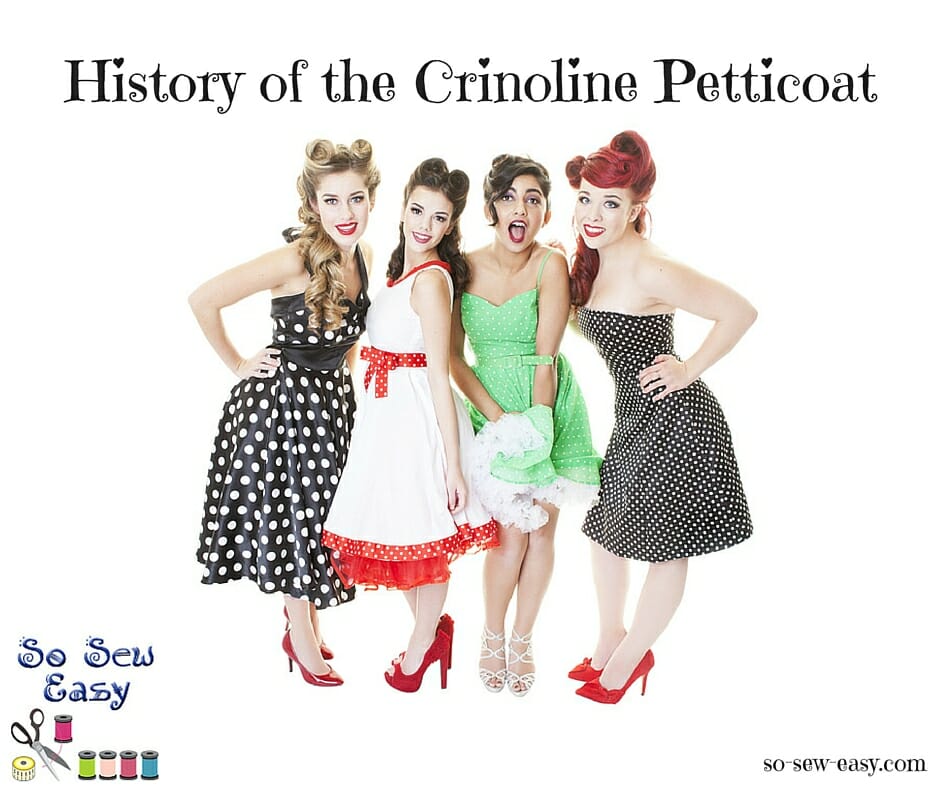
Think Mary Antoinette, Queen Elizabeth, or the recently revived 1950s Rockabilly movement, think Swan Lake and the fairy tale wedding gown. What do they all have in common? You’ve got it, serious petticoat action, brought to you by none other than the trusty, centuries-old crinoline…
Let’s take a closer look at this feminine phenomenon and you'll see that the crinoline petticoat has been the backbone of so many fashion movements throughout the ages.
Crinoline Petticoat Versions:
A crinoline is, in essence, a petticoat, structured with wire, wood, or other sturdy materials (in a cage formation or a hoop skirt) or made out of a stiff fabric of horsehair (“crin”) and cotton or linen, which would be gathered, layer upon layer, to make great big voluminous underskirts. The horsehair version was the original one but was later replaced (in the 1850s) by the caged hoop skirt.
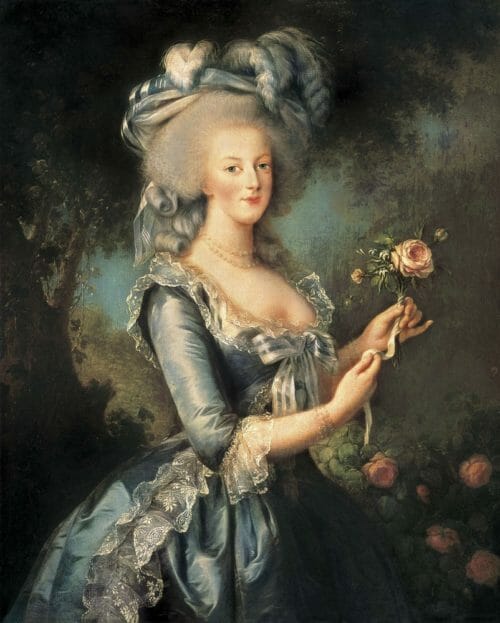

Earlier Versions:
The hoop-style crinoline was certainly not the first of its kind. Prior examples of structured petticoats, fulfilling the same function, were known in the 16th and 17th century as the farthingale (made of cane, whalebone, or willow) and in the 18th century as the pannier (the kind that Mary Antoinette wore, made of cane and extending out the sides, not the front). Although they went by different names they were, in essence, the same thing.
Horsehair Fabric:
The horsehair crinoline petticoat made its appearance in 1839, although the name described the fabric at first, it was soon being used to describe any kind of supportive petticoat or dress lining. With fabrics becoming increasingly intricately woven and heavy, crinoline (the fabric) was no longer sturdy enough for the job. It began to be replaced with quilted underskirts, stuffed with down and feathers (like carrying your duvet around town, fantastic). A stiffened cotton fabric was also sold as crinoline during this time.
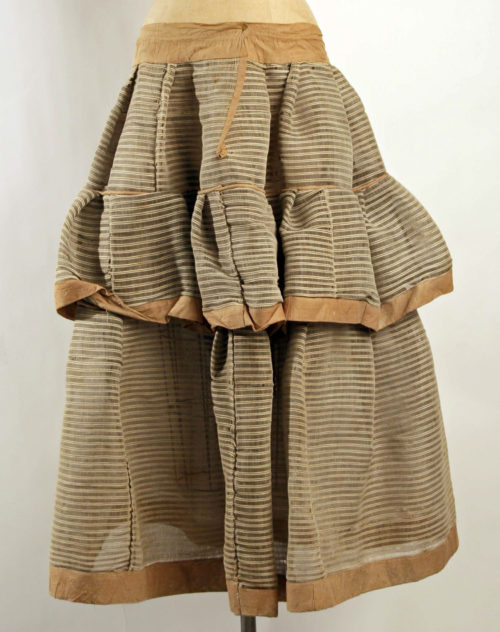

Crinoline Petticoat Hazards:
Worn by high-class women of leisure as well as factory workers and maidservants, the crinoline wasn’t always the most practical of undergarments, with a tendency to get caught in machinery, wheel-spokes, and wind; or to rather explosively take flame! Thousands of autopsies during the mid 19th century were signed… ‘death by crinoline’.


Keep in mind that fashion at this time was not so much voluntary as mandatory, women who dressed outside the norm would be sent packing, shunned from society. There are ample writings by men of the era which prove that the fashion was awkward for wives and husbands alike, many men found the fashion ridiculous but could do little to stop the spread of it.
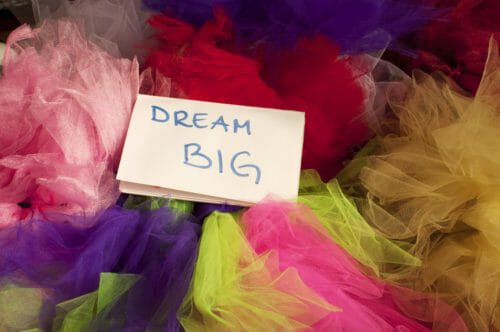

With so many crinoline-related deaths and the constant restriction of movement for women and their attendant husbands, women's rights activists began campaigning against such limiting fashions as the crinoline petticoat. Such activists felt that the hooped variety crinoline was a step up from the heavy and cumbersome multilayered fabric versions, however.
Queen Victoria (1855) is said to have detested the craze, a famous song of the time began with the lyrics “long live our gracious Queen, who won’t wear crinoline!” The fact is that this was a rumor which started when the Queen requested crinolines be ditched for her daughter's marriage, as the Chapel Royal just didn’t have that kind of space!
The Skeleton Petticoat:
The steel hoop crinoline (or skeleton petticoat) was first patented by RC Miller of Paris, where it first became a huge hit, in April 1856. Britain followed suit and soon, factories were producing them for every woman on the street. Skeleton petticoats consisted of steel hoops connected by strips of fabric tape, in some cases whalebone or cane were also used…even inflatable rubber, depending on the manufacturer (although the rubber variety had a terrible smell and was quite unpopular).
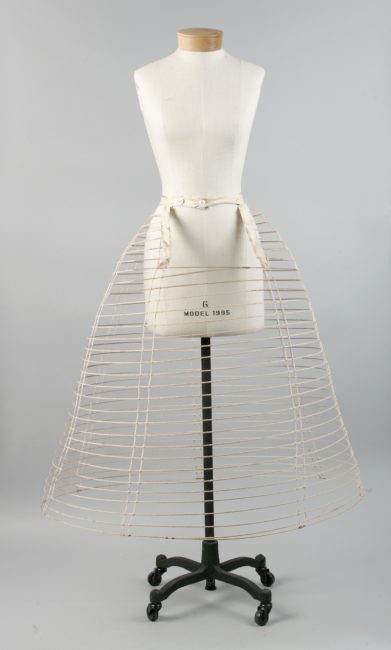

Indeed, hooped crinolines were cumbersome enough, women found it hard to pass through doors and, should they take a tumble or climb a flight of stairs, more would be revealed than was appropriate! At their height, crinolines would expand the skirts of the wearer by up to 6 yards (18 feet!) at the widest point, though they began to diminish in size until in the 1870’s they were replaced by the smaller crinolette and then later, the bustle.
The cage crinoline was revived in the 1880s to support the excessive bustles in fashion at the time, hoops would cross over one another to support the weight of the fabric. They were known as lobster pots because they so much resembled lobster cages.
New World Versions:
During WWI the crinoline took to the streets again, in full mid-calf length skirts with layered petticoats. It was considered patriotic to dress your best for men returning from war. The fashion continued through the 1920s and, in the 1930s, just before WW2, the hooped skirt returned. Queen Elizabeth really brought the fashion back. The bell-shaped, mid-calf crinoline was her nighttime and daytime look.
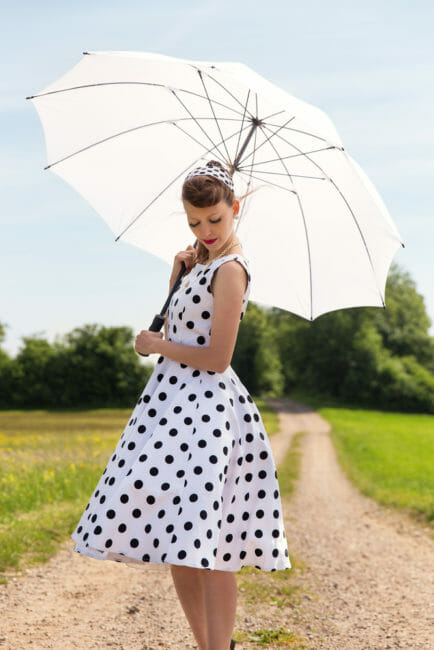

After the war, Christian Dior marketed the crinoline in the 1940s, although not the steel hooped version but the nylon net variety. Crinolines were massive with the Rockabilly movement of the ’50s (Greece: the movie, we all remember those iconic polka-dot dresses). Now, in 2016, Rockabilly style can be seen on the streets again in full form.
Crinolines, if you ask me, are a fashion that will keep on coming back one way or another. They are a way to enhance any silhouette and make a wedding, prom, or ball gown just that extra bit more special. When you think ‘fairytale', more often than not, what you should be thinking is ‘crinoline'.
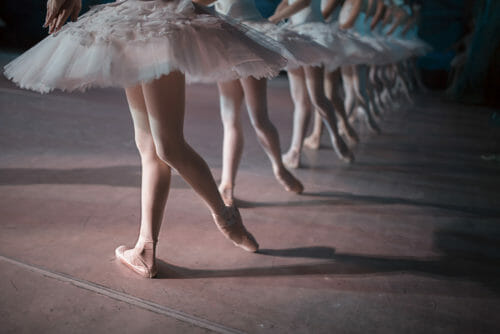









I wore can-cans/petticoats/crinolines to school and square dancing in the late ‘50s and early ‘60s. Some of mine were scratchy and some were not. In the ‘70s and ‘80s, our family square danced. My daughter and I had them to go with the colors of all our family’s different matching outfits. They were made of tens of yards in several layers of less scratchy, softer (but still bouffant) fabric. I loved wearing them because I felt so feminine.
In southwestern PA, in the late 50’s, many of us in high school had fabric-intensive skirts. They stood out nicely with reasonably-sized crinolines. One mistake I made: My mother had a collection of beautiful umbrellas. I was “creative” & noticed their shape when opened. One day, I starched (heavily) all my crinolines and draped them to dry on her opened umbrellas. Did you know that if you starch an open umbrella you can never close it again without ruining it? (In my closet today is her ONLY surviving umbrella!)
I was five or six living in Eastern Kansas and insisting I wear all three petticoats at once to go to church. I loved fashion then and still do now.
I remember my mother making us petticoats made with stiff rope put into two or three channels. They were less scratchy than some of the other versions and the stiffness of the rope made them stand out well!
In the.small Texas town where my grandparents and great aunts lived, it was known as a place to buy the net petticoat.
The seamstresses would make them of whatever color netting
They could get and display the petticoats on their front porches.
You just drove through and hoped to find your size and color!
Or special order and get on a wait list. To my little girl eyes, it was a beautiful sight.
I remember crinolines in the 1950s. My sister and I each had one that my mom made. She used a slip that was made out of the material like it’s stretchy nylon perhaps — it was the same material that our every day slips were made out of. The crinolines were made out of nylon net, sewn onto a piece of the slip material with an elastic waist. There would be about a 12 to 15 inches of the slip material and then huge amount of nylon net. The ends of the crinoline were covered with I think bias tape or ribbon perhaps and under the nylon net was a slip material so that they didn’t scratch your legs. I made one for my granddaughter a couple of years ago when I made her a circle skirt on her Christmas dress. She thought it was pretty special except that sitting down was hard! Crinolines can take up a lot of space????. I remember feeling very special when we wore our pretty dresses with our crinolines. Our dresses were made of cotton and if they hadn’t had the crinolines underneath would’ve looked quite ordinary. We felt like princesses with our sticking out dresses! What I want to wear them now? Not on your life!
I was a kid in the 50’s and was “forced” to wear crinolines under my dresses. They itched so bad. But I was a tomboy and preferred jeans and pullovers. Can’t climb a tree in a crinoline. I was so glad to see clothing streamlined in the sixties.
I remember them from the ’50s. Yes, they looked cute, but they scratched so badly. When I got older and wore hose, they always put pulls in them, so they were ruined. Can’t say I miss them at all!
I love how many women who were girls of the post-WWII era remember our crinolines. They were mandatory to being in style. Mom laid mine out, heavily starched, on a clean white sheet. They looked like giant flowers spotting the back yard. Then came ironing them so every ruffle stood out to its maximum. Like someone said, it was a generation of extreme change. Crinolines at 12, A-lines by 14, and bell bottoms and mini-skirts by 16.
My mother square danced in the ’60s and she had several crinolines – all itchy. She was never bothered by them because her mother had taught her to wear a simple slip underneath. It protected her skin from the itch.
I wore petticoat in the 50s. My Aunt made most of my clothes and the crionline was what I wore under my skirts. I am 79 years so I know what it meanstomwear petticoats. Thanks for the info.
The “men’s smoking room” at Shirley Plantation in Charles City County, Virginia, was built with narrow doors so the women could not enter. Even the female servants carrying refreshments to the room had to wait at the door for one of the male servants inside to get the tray. I thought that was an interesting way to keep the room “female free.”
My daughters’ service organization wears hoop skirts and crinolines under their formals at meetings & events. My grandmother remembered the stiff multilayered skirts and used to tell me when I was little that I would not have been so eager to wear one if I had to deal with it all day, every day! Give me my shorts & tank tops!! It cracks me up when these 13-year-olds want me to make them a dress full enough to go over a hoop. I am going to share this article with them.
This is how I dress NOW. I must own at least 30 petticoats, different colors and lengths. The only time I don’t wear them is right now in Texas when the heat gets over 100. I will wear them in the 90’s though. I also have a very few dresses that are slim skirts that I don’t wear them lol. I am a homemaker and have been for 38 years. I do not own a pair of pant or jeans. I wear a skirt or dress every day with heels covered with an apron that always coordinates. When I leave the house I also wear a hat and gloves. I get a LOT of compliments. Women will say they wish they had the gumption to dress like me but the main comments come from older men who say how much they miss seeing women dressed like me or younger men saying how refreshing it is to see someone actually care about how they look.
I would love to see pictures of some of your dresses!
That’s amazing! Do you have pictures posted anywhere we could see?
Thank you so much for a very interesting article. I still have a couple of net petticoats from the 50’s which my daughter has borrowed, we just didn’t starch them, but they still made the skirts stick out nicely.
I made a crinoline for the one and only wedding dress I made for a friend in another country. Since the climate was hot I lined her gown with 300 thread count cotton sheeting as well as the top of her crinoline. Since the dress was opaque, I used tulle in one of the colors of her wedding for a surprise flash while dancing.
PS. Autocorrect changed the name of “Grease” the movie to “Greece” the country.
I made one petticoat and purchased 3 more. I love the 50s dresses and have made quite a few of them. I also get nice comments when I go out dressed in one of my outfits. I also made a long skirt from the 1800s and have a huge poofy slip for under that one. I have worn it for Halloween with a Marie Antoinette wig. I LOVE the huge poofy style of those times!!! Thank you for this article!!
Hi Mayra. which pattern can i use to make it?
I don’t have one on the site yet, but I will be sharing my favorite pattern along with a 1950’s dress special for Christmas. Stay tuned!
Thanks Mayra, I enjoyed reading your article – I am trying to imagine what the horse hair version looked like?!
How fascinating! I never knew any of this. “Death by crinoline”… Just imagine.. Thankfully times have changed.
Ha – just wearing a crinoline in the summertime in the south would induce “death by crinoline” in me -it would not have to actually catch fire 🙂
Actually, probably any time of year… They do make a skirt have nice lines, sure – but just not worth the ick (and extra expense) factor involved in having to actually wear such a silly device!
When I was 14 I used to wear 2 crinolines under my full and also my broomstick skirts. Every evening I would put them in a kettle filled with a starch solution and then hang them outside on the clothesline. As they would be drying I would pull the layers apart to really get a good flounce. One had 3 layers, the other 2. I really had a lot of poof!!! On rainy or wintry days I hung them over the stationary tubs. One day, after school, it was pouring down rain so I walked with my cousin to her much closer house. We removed our soaked clothes, except our underwear and laid on her bed talking while my Aunt dryed my clothes. We were lying facing one another and when I got up to use the bathroom I let out a painful holler as my legs had stuck together from the starch which had dried between them. “VERY PAINFUL” (so much for keeping up with fashion)
I made myself 2 petticoats. ( Wt&blk).
I am rather amazed at the positive responses I receive when I wear them. I suggest making one. You’d be surprised that you actually probably own a few dresses it can be worn with!
“Make it and they will be worn”…
I love how you think…
So interesting to learn that history. When I was a little girl in the 50’s, we would call them “stick-out slips” because they made the skirt of your dress “stick-out”. :-). Sometimes they were sewn into the dresses and many times they were itchy and uncomfortable! My mother would say “sometimes you have to be pay the price to be beautiful”. ;-).
I remember having many, many crinolins when I was a young pre-teen and teen in the late l950’s and early 60’s. Mama used to wash them and starch them heavily and drape them over open umbrellas to keep their shape. When getting on the school bus, you had to clamp your arms tight against the skirt to keep the petticoats from blinding you (and the busdriver) while boarding. It seems we went straight from those frilly skirts to the hip-stitched fashion in a heartbeat. When I close my eyes, I can still see 3 open umbrellas in our kitchen covered in net.
Thank you for your VERY interesting take on history! I am 74 and when I was in high school (late 50s) the crinoline was VERY popular !!!!! The more the merrier! Imagine 3 girls to a seat on the school bus!!!! Skirts sticking straight up, up to our eyebrows!!!! (I’m sure the bus driver got slapped in the face every time a girl got on the bus and immediately turned to go down the [ very narrow] aisle!!!!
Very interesting. I can remember wearing a curtain rod wire in the hem of a petticoat (late 1950’s and then in the early to mid 1960’s the Huff n Puff petticoat became fashionable. This was a plastic tube (very like a bicycle wheel tube) which you blew up using the built in fitting (as used in inflatable beach balls). The endless tube was fitted into a soft material channel approx. 3/4 way down from the top of the petticoat. The draw back to this design was if wearing it when trying on a dress in the making. Pins would puncture it, if the wearer happened to sit down. Yes this happened to me but the manufacturer of petticoat did supply me with a new tube. What a nightmare to sew it back in place as the bottom edge of the channel had to be unpicked to remove the tube and then resewn when tune was in position.
Likewise, I recall wearing nylon net petticoats under my skirts to make them “stand out.” I hated them-they scratched your legs unless they were covered with ribbon, which most were not! They were particularly popular under square dancings skirts which my parents, and myself were “into” for awhile.
Great :-)!!
Thank you for this fun and interesting read!
Most welcome, happy you enjoyed it!
I love them!! Haven’t found the right way to make them yet. Although I wasn’t familiar with this name, so I’ll start googling again 😉
I will post a tutorial in the not too distant future, please stay tuned.
Please do My granddaughters would love them
As a little girl (born in 1953), I loved my petticoats. They made me feel special.
Hi Susan, how were they made back then? what fabrics? Thanks for sharing love to hear more about your experience.
Mine were made of nylon net, many layers with elastic waist bands. I can remember my great-aunt making one and saying lots of bad words while sewing. I believe they were store-bought after that.
LOL!
ohboy! I remember, in the 50’s and early 60’s that we collected petticoats in all colors and layered them to get our skirts to stick out as much as possible. FUN.